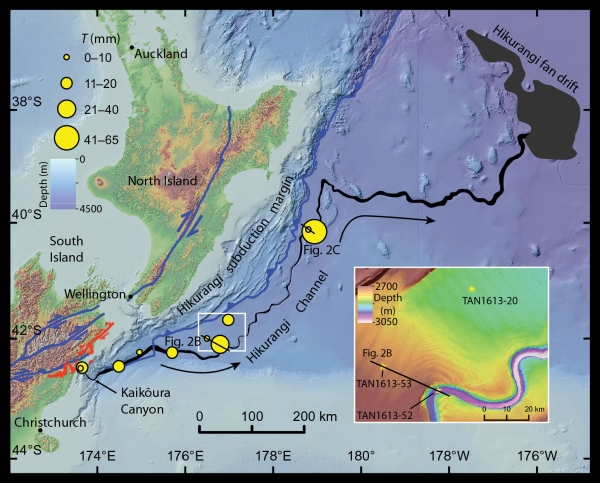Research conducted after the 2016, 7.8 magnitude Kaikōura earthquake has provided scientists with an extremely rare opportunity to understand the processes that shape submarine canyons.
The NIWA study reveals how earthquakes trigger landslides in seabed canyons, 'flushing' sediment into the deeper ocean. [Image: NIWA]
Pre and post-earthquake seafloor video, bathymetry, and sediment core samples collected from NIWA’s research vessel Tangaroa has shown that strong ground-shaking during the earthquake triggered widespread landslides in the Kaikōura Canyon, causing a powerful “canyon-flushing”. Canyon-flushing describes the process where high-energy currents transport sediment in the undersea canyon to the deep ocean.
Evidence showed the earthquake stripped over 850 million metric tonnes of sediment from the Kaikōura Canyon. It travelled more than 680km northeast along one of the world’s longest deepsea channels – the Hikurangi Channel. It’s the first time, globally, that the impact of a full canyon flushing event has been documented in such detail, providing scientists with an incredible benchmark to understand how the process works, and how the undersea environment and ecosystem recovers over time.
Flushing of submarine canyons can be triggered by a range of events, including earthquakes, typhoons and extreme river discharges.
“This study unequivocally demonstrates that earthquake-triggered canyon flushing is the primary process that carves out submarine canyons and delivers coastal sediment to the deep ocean,” says NIWA marine geologist Dr Joshu Mountjoy.
“The impact has been extreme, delivering 850 million metric tonnes of sediment to the deep ocean in one go – twice the annual sediment delivery of all New Zealand rivers.
“These results have proven long-standing scientific hypotheses about how submarine canyons are shaped. For the first time we’ll be able to quantify the scale, timing and seafloor impacts of a canyon-flushing event, giving us unique insight into this important global process,” says Dr Mountjoy.
Results also indicate canyons may form at a much faster rate than previously thought – as little as a hundred thousand years. Sediment flow generated by the quake carved into the rock underneath the canyon – deepening two main reaches of the Kaikōura Canyon by up to 50m, and the middle- canyon region by 20–30m.
Despite devastating the ecosystem, subsequent NIWA surveys have confirmed the former biodiversity hotspot is slowly recovering, with evidence of juvenile animals that once dominated the head of the canyon beginning to re-colonise the seafloor.
This study was part of a collaboration between NIWA, Victoria University of Wellington, GNS Science and international colleagues, funded by the Natural Hazards Research Platform and NWIA SSIF.

